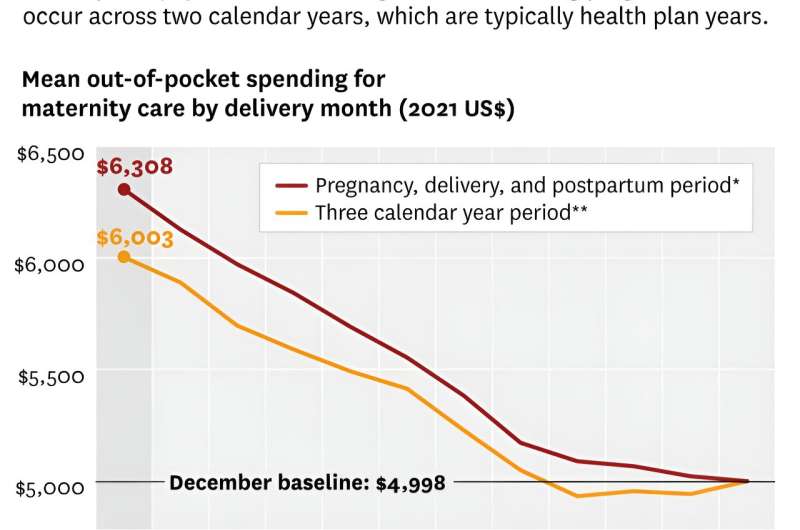This article has been reviewed according to Science X's editorial process and policies. Editors have highlighted the following attributes while ensuring the content's credibility:
fact-checked
peer-reviewed publication
trusted source
proofread
Study finds mothers pay more out of pocket when pregnancy crosses two calendar years

Mothers whose pregnancies span two calendar years could face higher out-of-pocket costs for maternity care simply because of when they became pregnant, according to a USC study published in the American Journal of Managed Care.
The study, from the USC Schaeffer Center for Health Policy & Economics, finds that some women with high-deductible health plans pay their cost-sharing limit twice during pregnancies that occur across two health plan years, which are typically calendar years. That can result in some patients paying $1,310 more, on average, for similar maternity care services.
"We have annual out-of-pocket limits on most commercial health care health plan products in the U.S., but the plan year beginning and ending dates are arbitrary," said study lead author Erin L. Duffy, director of research training at the Schaeffer Center.
"When episodic care lasts several months—like maternity care—and occurs within one plan year versus two, there can be big differences in cost-sharing for the same set of services."
"There's a bit of an unfairness inherent in that, especially if the differences in cost-sharing for maternity care aren't made up for through the enrollees' cost-sharing for other health care services," Duffy added.
The idea for the study came from conversations Duffy had at a prenatal yoga class when she was expecting her first baby seven years ago. Several moms-to-be explained that due dates in January instead of December dramatically increased their total out-of-pocket liability. That's because their health plans' out-of-pocket spending limits and deductible reset on Jan. 1, forcing them to pay at least their deductible twice plus any other cost-sharing.
Duffy and her colleagues sought to put some numbers behind the anecdotes. They analyzed the out-of-pocket spending of commercially-insured delivering mothers using claims data from the Health Care Cost Institute, covering patients enrolled in Aetna, Humana, and Blue Health Intelligence plans.
The study found that:
- Average out-of-pocket spending is highest among mothers who deliver in January and declines in each subsequent month until August and September, then flattens for the remainder of the year
- Average cost-sharing for pregnancy, delivery, and three months postpartum was $6,308 for mothers delivering in January and $4,998 in December, a difference of $1,310.
- Over a three-year period, patients delivering in January also had average out-of-pocket costs of $1,005 more than patients delivering in December, suggesting that differences in out-of-pocket spending by delivery month may not fully wash out over time.
"Changing cost-sharing limits to shorter intervals, such as monthly, may reduce potential arbitrary differences in cost sharing that occur due to pregnancy timing," Duffy said.
More information: Erin L. Duffy et al, Deductible Double Jeopardy: Patients May Pay More Out of Pocket When Pregnancy Crosses 2 Years. American Journal of Managed Care (2024). doi.org/10.37765/ajmc.2024.89562





















